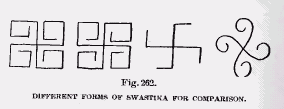

The Swastika
Forms Allied to the Swastika
Dr. Schliemann reports that a traveler of the Berlin Ethnological Museum obtained a pumpkin bottle from the tribe of Lenguas in Paraguay which bore the imprint of the Swastika scratched upon its surface, and that he had recently sent it to the Royal Museum at Berlin.
Meanders, Ogees, and Spirals, Bent To the Left As Well As To the Right.
There are certain forms related to the normal Swastika and greatly resembling it --- meanders, ogees, the triskelion, tetraskelion, and five and six armed spirals or volutes. This has
 been
mentioned above (page 768), and some of the varieties are shown in
fig. 13. These related forms have been found in considerable numbers
in America, and this investigation would be incomplete if they were omitted.
It has been argued (p. 839) that the Swastika was not evolved from the
meander, and this need not be reargued.
been
mentioned above (page 768), and some of the varieties are shown in
fig. 13. These related forms have been found in considerable numbers
in America, and this investigation would be incomplete if they were omitted.
It has been argued (p. 839) that the Swastika was not evolved from the
meander, and this need not be reargued.The cross with the arms bent or twisted in a spiral is one of these related forms. It is certain that in ancient, if not prehistoric, times the cross with extended spiral arms was frequently employed. This form appeared in intimate association with the square Swastikas which were turned indifferently to the right and left. This association of different yet related forms was so intimate, and they were used so indiscriminately as to justify the contention that the maker or designer recognized or admitted no perceptible or substantial difference between the square and spiral forms, whether they turned to the right or left, or whether they made a single or many turns, and that he classed them as the same sign or its equivalent. A Greek vase (fig. 174) shows five Swastikas, four of which are of different form (fig. 262). Curiously enough, the design of this Greek vase is painted maroon on a yellow ground, the style generally adopted in the vases from the mounds of Missouri and Arkansas, which mostly represent the spiral Swastika.
In Ireland a standing stone (fig. 215) has two forms of Swastika side by side. In one the arms are bent square at the corners, the other has curved or spiral arms, both turned to the right. These examples are so numerous that they would seem convincing in the absence of any other evidence. (figs. 166, 167, 168, 169, 170, 171, 172, 173, 174, 175 and 176).
ENDNOTES:
1. Cited in "Mission Voyage d'Italie," tome 1, p. 217; Dulaure, "Histoire des Differens Cultes," II; Brantône, "Dames Galantes"; Rabelais, "Pantagruel," 3, chap. 35. [Back]
<< Previous Page Next Page >>
© 2004-2007 Northvegr.
Most of the material on this site is in the public domain. However, many people have worked very hard to bring these texts to you so if you do use the work, we would appreciate it if you could give credit to both the Northvegr site and to the individuals who worked to bring you these texts. A small number of texts are copyrighted and cannot be used without the author's permission. Any text that is copyrighted will have a clear notation of such on the main index page for that text. Inquiries can be sent to info@northvegr.org. Northvegr™ and the Northvegr symbol are trademarks and service marks of the Northvegr Foundation.

|